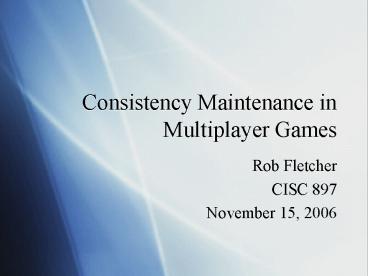Consistency Maintenance in Multiplayer Games - PowerPoint PPT Presentation
1 / 36
Title:
Consistency Maintenance in Multiplayer Games
Description:
Violent Action Game. Violent Action Game. Adventure Game. Adventure Game. Dress Up Games ... do exist, however in games they are prohibitively expensive. ... – PowerPoint PPT presentation
Number of Views:80
Avg rating:3.0/5.0
Title: Consistency Maintenance in Multiplayer Games
1
Consistency Maintenance in Multiplayer Games
- Rob Fletcher
- CISC 897
- November 15, 2006
2
Outline
- The Problem
- Our Solution
- Why Our Solution Works
3
The Problem
- What is consistency maintenance?
- Why is it important?
- Why is it hard?
- What are the considerations?
4
Consistency Maintenance
- Consistency maintenance deals with keeping sets
of replicated data equivalent - In client-server games, the canonical worlds
game state is stored on the server - Some or all of the game state is replicated on
each of the clients in order to be rendered and
represented to the player
5
Consistency Maintenance
- Players interact with their replicas of the game
world - Any changes to the game world are sent back to
the server - Server then updates all the client replicas with
these new changes
6
Why is it Important?
- Consider the following scenarios
7
Violent Action Game
8
Violent Action Game
9
Adventure Game
10
Adventure Game
11
Dress Up Games
12
Its Hard
- Many cheats in multiplayer games exploit
consistency maintenance flaws - Object duplication (duping)
- Perfect consistency algorithms do exist, however
in games they are prohibitively expensive. - If you dont get consistency maintenance right,
players get angry, leave.
13
Its Hard
- Concurrency and Consistency maintenance
algorithms (such as those using locking) ensure
that all data stays the same - Imagine if every movement you made in an FPS
required several exchanges between the client and
server - Slower transactions are acceptable in a trading
situation, inappropriate in high feedback
interactions
14
Aspects of the Player Experience
- Choice of consistency maintenance scheme affects
player experience - Some of these aspects are fidelity, feedback,
rate of animation, and warping.
15
Fidelity
16
Feedback
17
Rate of Animation
18
Warping
19
Trading off Aspects of the Player Experience
- In action games, you want very fast feedback
- You can trade fidelity for feedback by using
predictive algorithms - Predictive approaches are optimistic algorithms
20
Trade-Offs
- When high fidelity is required (such as in
trading situations) you can exchange feedback for
fidelity - These are usually referred to as pessimistic or
conservative algorithms
21
Previous Work
- There is a lot of research into consistency
maintenance approaches - Particularly in groupware research
- Multi-user collaborative drawing programs
- Multi-user collaborative text editors
- They understand trading off aspects of the user
experience
22
Previous Work
- Pessimistic algorithms using locking
- Optimistic algorithms
- Rollback
- Operation Transform (Ellis and Gibbs)
- Timewarp (Edwards and Mynatt)
23
Our Solution
- Plug-replaceable consistency maintenance
- Workspace model provides us with the
infrastructure - Separate game logic and consistency maintenance
- Lets us quickly benchmark a handful of different
consistency maintenance schemes
24
Quick Introduction to Workspace
- Proud product of the EQUIS lab
- Allows for a high level, diagrammatic definition
of the intended behaviour of a distributed
groupware system - Refines it to an implementation level
architecture at runtime based on available
resources
25
Conceptual Level Architecture
26
Possible Replicated Refinement
27
CCCM
- Consistency and Concurrency Control Module
- Intercepts all calls to synchronized components
- Communicates with fellow CCCMs
- Embodies a consistency maintenance scheme
28
Many CCCMs
- We can create a handful of different CCCMs, each
using a different consistency maintenance scheme - Through the use of refinement hints, we can
choose which CCCM to use for each set of data - We can switch between them without recompiling to
compare their behaviour
29
Why Our Solution Works
- We conducted a case study on a very simple game
- This game required a villager to traverse a
series of waypoints - Villager movement was controlled by the server,
client simply observed - Measured fidelity, rate of animation, and warping
30
Our Game
31
Controlled Variables
- We ran the experiment nine times, 15 minutes each
time - We used 3 different CCCMs under 3 different
latency situations - No Latency (0 ? 0ms)
- Low Latency (100 ? 10ms)
- Medium Latency (500 ? 100ms)
- Server sends update every 500ms
32
Our CCCMs
- Non-Predictive CCCM
- Client updates every message from server
- Client does not attempt to extrapolate villager
position
33
Our CCCMs
- Two predictive CCCMs
- Extrapolates position between server messages
- Optimized Predictive CCCM estimates latency as
well for higher fidelity
34
(No Transcript)
35
Conclusion
- Plug-replaceable CCCMs provide many advantages in
game development - Separation of concerns between consistency
maintenance and game logic - Ability to quickly compare various approaches
- Facilitates the development of a library of
reusable CCCM components
36
References, Further Information and Questions
- R. D. S. Fletcher, T. C. N. Graham and C. Wolfe.
Plug-Replaceable Consistency Maintenance for
Multiplayer Games, in NetGames 06 Proceedings
of the 5th Workshop on Network and System Support
for Games, pages TBA, New York, NY, USA, 2006.
ACM Press. - fletcher_at_cs.queensu.ca































